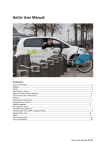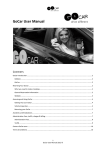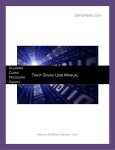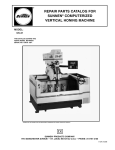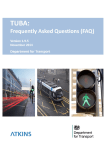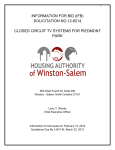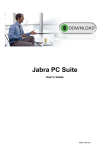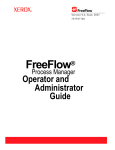Download User manual – rev00214
Transcript
Metrici LPR Freeflow – User manual rev. 00214 | May 2013 Table of contents CHAPTER 1 – System description.................................................................................................................2 CHAPTER 2 - Constructive details and instructions for installation and use.................................................5 CHAPTER 2.1 - AQUISITION block.....................................................................................................5 CHAPTER 2.2 - PROCESSING block...................................................................................................9 CHAPTER 2.3 - ADMINISTRATION AND REPORTING BLOCK.............................................................14 ANNEX 1 - Frequently Asked Questions......................................................................................................24 ANNEX 2 - External queries........................................................................................................................25 www.metrici.ro Pagina 1 / 26 Metrici LPR Freeflow – User manual rev. 00214 | May 2013 CHAPTER 1 - System Description Metrici LPR is a license plate recognition solution for plates mounted on vehicles, licensed and labeled in accordance with standards existing in each country. Main features: • 'Free flow' operation, which involves real-time analysis of video streams from IP capture cameras; • Recognition of an unlimited number of license plates in the same picture frame; • Syntax analysis and simultaneous recognition of license plates for several countries; • Distributed operation (multiple cameras in multiple locations), with centralized reporting and administration; • 3 actions defined for each recognized license plate number: opening barriers, sending warning e-mails, popup display on screen; • Multi-user reporting and administration interface with secure access and viewing rights for each location and user; • Multi-threading operation with autoranging based on the number of cores/threads available; Metrici LPR can be used, day or night, for traffic monitoring systems, tolling and vignette control systems, parking, access control, border monitoring, industrial weighing systems, outdoor advertising auditing, gas stations and many other applications. www.metrici.ro Pagina 2 / 26 Metrici LPR Freeflow – User manual rev. 00214 | May 2013 The system can be configured flexibly, as needed. At the functional level, it consists of 3 interconnected blocks: ACQUISITION, PROCESSING, ADMINISTRATION AND REPORTING. An example of a technical structure for a client who owns 3 locations can be seen in the following scheme: www.metrici.ro Pagina 3 / 26 Metrici LPR Freeflow – User manual rev. 00214 | May 2013 The ACQUISITION block consists of one or more IP cameras, one for each access point monitored, and auxiliary equipment (IR illuminators, PoE switches etc). The PROCESSING block consists of one or more computers containing software for real-time analysis of incoming video streams received from the IP cameras. Each interconnected camera needs its own analysis application. Analysis applications are multi-threading and, therefore, they work faster on multicore and/or multiprocessor systems. Multiple analysis applications can be used simultaneously on the same computer. The ADMINISTRATION and REPORTING block consists of a web interface application that receives data from the analysis application and can display them in a user friendly way. This application can be located on one of the computers for ANALYSIS or a completely independent computer. Between the PROCESSING and ADMINISTRATION AND REPORTING blocks, there is no need to have IP connectivity on the local network; it is sufficient to have a public network allowing traffic on port 80. www.metrici.ro Pagina 4 / 26 Metrici LPR Freeflow – User manual rev. 00214 | May 2013 CHAPTER 2 - Constructive details and instructions for installation and use. CHAPTER 2.1 - AQUISITION block. Video stream acquisition can be done with IP cameras that are able to deliver MJPEG stream through the HTTP protocol. For the best possible detection, the video cameras must be infrared sensitive (IR) and to have IR illumination, even during the day. Also, it is recommended to mount an additional MLPF filter (Metrici Low Pass Filter), with low visible light transmittance and high infrared transmittance (see the the curve in the image P0). Image P0 - Characteristic curve of low visible light transmittance filter. In this way, the system will be much less exposed to illumination disturbances caused by strong sunlight or headlights. www.metrici.ro Pagina 5 / 26 Metrici LPR Freeflow – User manual rev. 00214 | May 2013 Camera and illuminator selection When choosing a video camera and its related IR illuminator, the following must be taken into account: • The width of the license plate number in the image must be of at least 200 pixels, so that recognition accuracy be as high as possible. This means that a lower resolution, but higher zoom camera, or a high resolution, but lower zoom camera can be used. For guidance, for a 1 Mpixel resolution camera, maximum distances to vehicles monitored and, thus, license plate numbers, may not exceed the following values: Camera lens vs distance to plate number • Maximum distance (meters) 10 20 25 30 Lens (degrees) 30 15 10 7.5 When opting for a zoom camera or for narrow angle lens, an IR illuminator with similar optical characteristics (angle, distance) must be chosen. For example, we must not choose a 15-degree lens camera and an illuminator with 120-degree scattered light, because this involves a reduced performance for the entire system. • Image acquisition time (shutter speed) must be in accordance with monitored vehicle speed and lighting conditions. We can choose a camera with low shutter speed (slow), only if the vehicles are moving slowly. On the other hand, a high shutter speed means a lower acquisition time and, thus, a smaller amount of light reaching the camera's sensor. In all cases, it is very important that the license plate numbers have a very clear image (no blur), whatever the lighting conditions are in that point of measurement. A common mistake is to configure the assembly during the day, without taking into account the lighting conditions in the evening or night. The distance traveled by a car moving at a speed of 50 km/h as against the point of measurement is 13.88 m every second. For a camera with a shutter speed set to a value of 1/30 sec, this means that during the acquisition of an image (frame), the car (and, thus, the plate number) has moved 0.46 m. This distance translates into a blurred image and into the impossibility of accurately recognizing characters that make up the license plate number. An example of an incorrect configuration of these parameters can be seen in image P2. www.metrici.ro Pagina 6 / 26 Metrici LPR Freeflow – User manual rev. 00214 | May 2013 Image P2 - Shutter speed incorrectly set during the day. Result: Unclear number. For guidance, depending on the relative travelling speed of the vehicle, we recommend the following minimum values for the shutter speed: Shutter speed Car speed 10 km/h 30 km/h 50 km/h Shutter speed 1/250 s 1/500 s 1/1000 s When you can not increase the shutter speed high enough, an alternative solution is to reduce the relative speed of the vehicle as much as possible, in the image, as against the point of measurement. This can be done by changing the angle of the camera as against the direction of travel of the vehicles (e.g. front view, from low height, at small angles as against the horizontal). Along with a shutter time adjusted to the type of application, you must also configure accordingly other operating parameters of the video camera. We recommend to use a gain value as small as possible and to disable edge enhancement, WDR and backlight correction features. The video camera and IR illuminator should be placed as close to each other as possible. Due to www.metrici.ro Pagina 7 / 26 Metrici LPR Freeflow – User manual rev. 00214 | May 2013 the retro-reflectivity feature of the license plates, a light beam sent from a certain angle to a plate number is reflected back in the same direction. For this reason, it is not necessary to mount the acquisition assembly with the view direction perpendicular to the registration number plane. A common practice is to place the two units one under the other on a column with a height of 1~3 m, 1~2 m near the path of motor vehicles. Slopes of +/- 20 degree of the registration number are allowed, in any direction, as to the video camera vision horizontal. Imagine P3 - Camera incorrectly positioned, on the east-west direction. In cases where constant artificial shadow in the detection area can not be ensured, special attention will be given to camera positioning in relation to the sun. Avoid as much as possible its positioning parallel to the east-west direction, due to the unpleasant effects occurring at sunset or sunrise, when the sun is near the horizon. Also, the irregular shadows that can be dropped within the detection perimeter by buildings (e.g. walkways, stairs, columns) must be studied, as they can affect recognition accuracy. Some of these effects can be reduced by installing a MLPF-1 or MLPF-2 optical filter on the camera lens, along with additional infrared illumination in daylight. www.metrici.ro Pagina 8 / 26 Metrici LPR Freeflow – User manual rev. 00214 | May 2013 Depending on your needs, you can choose CMOS or CCD sensor video cameras. Cameras with CCD sensor usually have better sensitivity, allowing higher values of the shutter speed without seriously altering the frame rate, but they feature lower resolutions. In return, CMOS cameras typically have higher resolutions, but a higher shutter speed also means a lower frame rate. For applications where the relative speed of the vehicles is not very high and distances are of the order of several meters (e.g. parking, access points with barrier), our recommendation is to choose a moderate zoom CMOS sensor camera. For applications where speeds are high, we recommend choosing a camera with CCD sensor and high zoom, to compensate for the lower resolution of the sensor. The frame rate of the images from the stream produced by the video camera is more important, the higher the relative speed of vehicles in relation to the point of measurement is. The analysis application needs an average of 2~3 frames containing the same license plate number in order to have a better recognition accuracy and to eliminate possible erroneous results. For this reason, both the choice of components forming the acquisition block (cameras, filters, IR illuminators) and their location have a crucial role in the overall performance of the LPR system and they must be treated with utmost care. CHAPTER 2.2 - PROCESSING block. The processing block consists of one or more computers on which applications for analysis and recognition of license plates are installed and running. Each interconnected video camera needs its own analysis application; on the same computer, multiple such applications can run simultaneously. We recommend using computers with last generation Intel or AMD processors and avoiding the older generation AMD processors (e.g. Phenom II, Athlon II), because they have do not have the SSE/SSE2 instruction set fully implemented. Every analysis application runs in multi-threading mode and has autoranging option at startup, depending on the number of threads allowed by the computer. As a general rule, the more execution threads available, the more the analysis application will be able to run in real time with higher resolutions and more FPSs. For guidance, the analysis of a video stream with a resolution of 1 Mpixel at 5 fps needs 2 processor threads at 2 GHz and 1 GB RAM. For example, for a parking access application with two 1 Mpixel video cameras, where cars are moving slowly or are stationed at the barrier, one computer having an INTEL i3 processor and 2 GB RAM can be used (e.g. INTEL NUC), and for an application to monitor car traffic on public roads with 4 2-Mpixel and 10 fps cameras, you can use a server having INTEL Xeon www.metrici.ro Pagina 9 / 26 Metrici LPR Freeflow – User manual rev. 00214 | May 2013 E5-2670 processor and 8 GB RAM. Recommended Cameras Cameras Cameras 1-2 3-6 7-10 Processor Core i3 3217 Xeon E3-1275 Xeon E5-2670 Memory 4 GB 8 GB 16 GB Storage 32 GB (mSATA SSD) 2 x 250 GB SATA RAID 1 2 x 500 GB SATA RAID 1 Power consumption 50 W 300 W 500 W Sizes Ultra compact 10 cm x 1U 1U Linux (Fedora Core, Linux (Fedora Core, Linux (Fedora Core, Centos, Debian) Centos, Debian) Centos, Debian) Intel NUC HP DL 120 G7 HP Proliant DL-360 hardware 7.2 cm Operating system Reccomended model The main interface of the application allows you to view real-time video stream from the camera and its analysis results. www.metrici.ro Pagina 10 / 26 Metrici LPR Freeflow – User manual rev. 00214 | May 2013 A precisely recognized license plate number is framed in green. A yellow framing indicates a low recognition precision, while red indicates an unrecognized number. The upper right side presents the processed image of the last recognized number and, below, the alphanumeric content of that number. In the lower right side, there is a list of the last numbers recognized, their country code, first and last time of recognition and the probability of their recognition. Recognition probability may vary between 0 and 1, the latter being the maximum possible value. The more successive frames a license plate number is recognized in, the probability value is more close to 1. After processing a single frame, the maximum probability can not exceed a value of 0.5. By pressing the Settings button, you can change at any time the analysis application execution settings, as follows: The first section refers to the connectivity with the video camera and it includes the following fields: • Input stream type with one of the following values: • HTTP Mobotix MJPEG - for Mobotix cameras (e.g. M24 LPF); • HTTP VLC MJPEG - for video streams played back with the VLC application; • HTTP Android MJPEG - for cameras present on Android phones using the 'IP Webcam' application; www.metrici.ro Pagina 11 / 26 Metrici LPR Freeflow – User manual rev. 00214 | May 2013 • HTTP ACTi MJPEG - for ACTi cameras (e.g. KCM-5611); • HTTP AXIS MJPEG - for AXIS cameras (e.g. P1346); • HTTP HIKVISION MJPEG - for Hikvision cameras (e.g. DS-2CD855F-E). • Input stream IP address - IP address of the camera; • Port - TCP listening port of the camera; • Input stream user - user name to connect to the camera (can be left blank, if the camera does not have this option configured); • Input stream pass - password to connect to the camera (can be left blank, if the camera does not have this option configured). The second section relates to connectivity with the reporting system and consists of the following fields: • Reporting URL - address of the reporting script where data of all recognized numbers and images associated to vehicles and number plates are sent. Format: http://IP_ADDRESS/io/new_plate_event.php. If the administration and reporting interface is installed on the same computer with the analysis application, IP_ADDRESS is set to 127.0.0.1. • Check action URL - address of the script where actions to be taken, when a number is recognized, are checked. The 3 actions can be configured via the administration and reporting interface and they include: opening barriers, sending emails, posting of a popup message on screen. Format: http://IP_ADDRESS/io/check_action.php. If the administration and reporting interface is installed on the same computer with the analysis application, IP_ADDRESS is set to 127.0.0.1. • Check action minimum probability - minimum probability for each number recognized, from which the checking operation of actions to be taken for that number are initiated. Generally, it is preferable to use a value > 0.5. • Reporting / check action - authkey / id - these two values are generated by the reporting and administration interface when adding a new camera. With their help, authentication of communication between the analysis and reporting applications is fully automatic and bidirectional, enabling secure communication over insecure networks and Internet. The third section refers to various internal settings of the analysis application and includes the following fields: • Same plate delay - the time measured in seconds that the analysis application waits the recurrence in the frame of the same license plate number. After this period, the recognized number is sent to the reporting application and is removed from the list of detected numbers. We www.metrici.ro Pagina 12 / 26 Metrici LPR Freeflow – User manual rev. 00214 | May 2013 recommended values of 1~2 seconds for traffic surveillance applications on public roads and higher values for parking access applications. • Plate min. length and plate max. length - minimum and maximum length that a license plate can have in the image. A too low minimum value may cause wrong recognitions and a too high maximum value may lead to undue wasting of the processing power. We recommend a minimum value greater than 200 pixels, in order to have a recognition accuracy as good as possible. • Open barrier URL - address of the equipment controlling the barrier opening, if present (this field can be left blank). Instead of a barrier, a light-signaling equipment or any device controlled through the HTTP protocol can be used. If data visualization is done only through the reporting and administration interface, the analysis application can be started with the -nogui parameter. In this mode, the application does not display anything, allowing its inclusion in shell scripts for automatic startup. Also, by not displaying the interface and the video stream from the camera, it frees some of the processing power. www.metrici.ro Pagina 13 / 26 Metrici LPR Freeflow – User manual rev. 00214 | May 2013 CHAPTER 2.3 - ADMINISTRATION AND REPORTING BLOCK. The ADMINISTRATION and REPORTING block consists of a web interface application that receives data from the analysis application and can display them in a user friendly way. This application can be located on one of the computers for ANALYSIS or a completely independent computer. Between the PROCESSING and ADMINISTRATION AND REPORTING blocks, there is no need to have IP connectivity on the local network; it is sufficient to have a public network allowing traffic on port 80. The first time you access this interface, you must use the following login: E-mail: [email protected] Password: metriciadmin For security reasons, please change this password after logging in, by accessing the Administration menu and then clicking User Administration submenu. www.metrici.ro Pagina 14 / 26 Metrici LPR Freeflow – User manual rev. 00214 | May 2013 Before you can use the analysis applications, you must define the locations and the cameras available in each location by accessing the Administration menu, then Locations & Cameras submenu. By pressing the Add new location button, you can define a new location, which can then contain one or more capture cameras. After adding new locations, you can define one or more cameras in that location by clicking on the name of the location and then clicking the Add new camera button. www.metrici.ro Pagina 15 / 26 Metrici LPR Freeflow – User manual rev. 00214 | May 2013 The application will generate an authentication key (Authkey) and an ID that must be entered in the Settings window of the analysis application, which will be connected to the camera. By accessing the Setup submenu of the Administration menu, the following parameters can be changed: • Owner's name; • Minimum probability displayed - number plates recognized with a probability below this value will not be displayed; • Language; • E-mail address - e-mail from where alerts are sent automatically, according to the actions defined for each license plate number; www.metrici.ro Pagina 16 / 26 Metrici LPR Freeflow – User manual rev. 00214 | May 2013 • Show original plate - if checked, it will display both the reconstructed license plate number and its processed image. Attention! The Administration menu is not visible to users who do not have the Admin checkbox ticked. By accessing the Logs menu, you can see the list of operations performed by users, filtering being possible both by display date and by user. Users without admin rights can only view personal operations logs. www.metrici.ro Pagina 17 / 26 Metrici LPR Freeflow – User manual rev. 00214 | May 2013 The Cars menu offers the possibility to view the list of recognized license plate numbers, having a recognition probability greater than or equal to the value set in the Administration menu, Setup submenu. Filtration can be done by date, country code, location or camera. Only locations and cameras for which the user has viewing rights are displayed. For every license plate number, the table displays the recognized alphanumeric content, country code, the time when it was recognized, location and camera. The right side displays the reconstructed plate number and, next to it, the processed image of the number, if this option was selected in the Administration menu, Setup submenu. You can find below the car photo and a few quick links to reporting and action defining. If you click on the car photo or its number, they can be viewed at the original size, without scaling, as they were captured by the video camera. www.metrici.ro Pagina 18 / 26 Metrici LPR Freeflow – User manual rev. 00214 | May 2013 You can perform a quick search, filling in the field in the blue box and clicking the Find plate button. You can fill in only a part of the number and the system will search for and display all numbers matching that condition. For example, if you search for GL, the system will return both the GL 17 VGN and the B 100 GLA or TR 34 AGL number. Several synthetic reports on vehicle traffic can be viewed by accessing the Reports menu. The Cars each hour report shows the total number of cars and the number of unique cars, by time of day. You can choose the start and end date and the report type, SUM = hourly sum during the reporting period, or AVERAGE = hourly average during the reporting period. If the start date is the same as the end date (reporting on one day), then SUM = AVERAGE. www.metrici.ro Pagina 19 / 26 Metrici LPR Freeflow – User manual rev. 00214 | May 2013 www.metrici.ro Pagina 20 / 26 Metrici LPR Freeflow – User manual rev. 00214 | May 2013 By accessing the Cars each day report, you can view the total number of cars and the number of unique cars, values consolidated on the reporting period days. www.metrici.ro Pagina 21 / 26 Metrici LPR Freeflow – User manual rev. 00214 | May 2013 The Cars each month report shows a similar situation to the Cars each day report, but consolidated on the months included in the reporting period. www.metrici.ro Pagina 22 / 26 Metrici LPR Freeflow – User manual rev. 00214 | May 2013 The last report, Top cars, shows the list of cars that have passed most frequently through the detection zone. For each license plate number in the list, you can see the total number of events, the number of events of the current day, the current week and this month. Also, it is possible to quickly define an action (open barrier, send email, popup display) or to modify the existing one. www.metrici.ro Pagina 23 / 26 Metrici LPR Freeflow – User manual rev. 00214 | May 2013 ANNEX 1 - Frequently Asked Questions Q: What happens if the data communication between the analysis application and the reporting and administration application is interrupted for a while? A: In such cases, the analysis application stores locally the data processed (license plate numbers, timestamps, photos etc.) indefinitely and continuously monitors the state of the data connection. When it is restored, it sends at full speed all locally stored data to the reporting and administration application. Attention! Over the connectivity downtime, verification of actions to be taken for each license plate number can not be done and, therefore, for example, barrier opening will not work. Q: Shortly after starting the analysis application, it turns off by itself. What is the cause? A: This behavior is due to the absence or malfunction of the HASP license key. Please check that the key is correctly connected to one of the USB ports of the analysis computer and that the red LED in its end is lit. Key operation can be checked by accessing it with a web browser (e.g. Mozilla Firefox) on your analysis computer, address: http://localhost:1947 . If the key is not detected, enter the HASP key in another USB port. www.metrici.ro Pagina 24 / 26 Metrici LPR Freeflow – User manual rev. 00214 | May 2013 ANNEX 2 - External queries Metrici LPR stores data obtained in a MySQL relational database. Information such as license plate numbers, times when they were seen, countries of origin, locations, photos of cars and of recognized license plate etc., can be found easily by a human operator through embedded administration and reporting interface. For cases which require integration with management/ERP third-party solution, you can send queries directly to the database server via a SQL TCP/IP connection, which runs on the 3306 port. For example, to retrieve the list of cars that passed through 'Intrare Splai' on October 9, 2012, between 03:00 and 04:00 p.m., you can use a query such as: mysql> SELECT plates.number, plates.last_seen FROM plates, cameras WHERE DATE(plates.last_seen)='2012-10-09' AND HOUR(plates.last_seen)='15' AND probability>=0.5 AND plates.camera_id=cameras.id AND cameras.name='Intrare Splai'; +----------+---------------------+ | number | last_seen | +----------+---------------------+ | MAI25176 | 2012-10-09 15:11:28 | | B38WSJ | 2012-10-09 15:12:09 | | B65FWJ | 2012-10-09 15:13:04 | | B88NTC | 2012-10-09 15:14:36 | | B16TNH | 2012-10-09 15:26:36 | | B101TMN | 2012-10-09 15:32:55 | | B123ATI | 2012-10-09 15:34:45 | | B44DLV | 2012-10-09 15:35:18 | | B93YSJ | 2012-10-09 15:42:19 | | B67GNM | 2012-10-09 15:47:35 | | B96BTU | 2012-10-09 15:48:28 | | VL07UJO | 2012-10-09 15:48:30 | | B168EEN | 2012-10-09 15:52:10 | +----------+---------------------+ 13 rows in set (0.09 sec) Or, to find the times when a car with the number 'VL 07 UJO' was seen in the last 10 days at the same entrance, you can use a query such as: mysql> SELECT plates.number, plates.last_seen FROM plates, cameras WHERE plates.number='VL07UJO' AND DATE(plates.last_seen)>=DATE_SUB(CURDATE(), INTERVAL 10 DAY) AND probability>=0.5 AND plates.camera_id=cameras.id AND cameras.name='Intrare Splai'; www.metrici.ro Pagina 25 / 26 Metrici LPR Freeflow – User manual rev. 00214 | May 2013 +---------+---------------------+ | number | last_seen | +---------+---------------------+ | VL07UJO | 2012-10-01 12:39:07 | | VL07UJO | 2012-10-01 16:34:04 | | VL07UJO | 2012-10-09 15:48:30 | | VL07UJO | 2012-10-09 20:28:41 | | VL07UJO | 2012-10-10 10:48:10 | +---------+---------------------+ 5 rows in set (0.00 sec) Also, it is very easy to find out the number of cars that passed through the same entrance two days before: mysql> SELECT COUNT(plates.number) FROM plates, cameras WHERE DATE(plates.last_seen)=DATE_SUB(CURDATE(), INTERVAL 2 DAY) AND probability>=0.5 AND plates.camera_id=cameras.id AND cameras.name='Intrare Splai'; +----------------------+ | COUNT(plates.number) | +----------------------+ | 388 | +----------------------+ 1 row in set (0.09 sec) On request, we can provide other types of connection interfaces, e.g. using HTTP protocol, using GET methods. www.metrici.ro Pagina 26 / 26



























